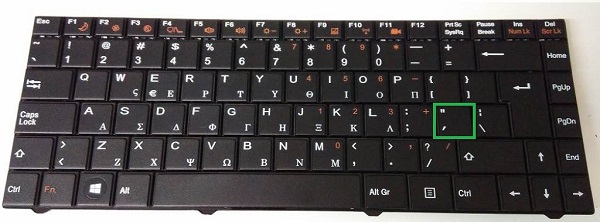FONTS for GREEK
⇑
- ALSO CHECK GENERAL LINKS
- **Standard Modern Greek: Normally you will have no problem reading it from your browser. This is the font you need to read greek webpages in general. It uses only one stress accent, hence it is called monotonic.
- **Ancient Greek is polytonic (multiaccented) and needs specialized fonts. Some, exist in your computer anyway (I use Arial Unicode MS). Philologists and linguists may need this kind of fonts. Normally, you do not need it.
-
- Test your browser for greek
- The following examples should look similar (the two words displayed, mean: greek letters: hellenica grammata).
- TEST MODERN GREEK FONTS
- 1.
 this is an image
this is an image
- 2. ελληνικά γράμματα this is written with &#...; code:
ελληνικά γράμματα
- 3. ελληνικά γράμματα this is written in greek directly from my keyboard.
- TEST POLYTONIC GREEK FONTS FOR ANCIENT GREEK
- 1.
 this is an image
this is an image
- 2. ἑλληνικά γράμματα
this is written with &#...; code.
As you can see, the only difference between the above monotonic and polytonic examples, is the first letter. The code for polytonic is different (ἑ), and supported by the font-family arial unicode ms
- 3. I cannot supply you with a test on written polytonic directly from my keyboard because i have never installed it... sorry!
-
- Display greek at your browser
- language code for greek is el (the first two letters of the sound of the word: mod.gre.pronunc: [elini'ka] = hellenic
- **Modern Greek & Ancient Greek
- no problem. If there is, check the encoding preferences.
- Greek fonts are already installed in your computer, and browsers are directing to the greek option (charset=iso-8859-7). or UNICODE charset=utf-8.
- The ancient greek fonts (with various accents) are the: 'greek extended' fonts. Type: Palatino Linotype, Arial, are good.
-
- Write greek: the keyboard
- **Modern Greek
- no problem: choose Greek at your languages-preferences button.
- then, your keyboard operates like this:
- for accent: press the accent, then the vowel (e.g. ά), or for capital: the accent, then shift+vowel (Έ)
- for Umlaut: press shift+theaccent, then the letter ( ϊ ϋ) or for capital: shift+theaccent_theltter (Ϊ Ϋ)
- for the iota with Umlaut AND accent: press shift W(the ς)+theletter. or copy here: ΐ ΰ

- **Ancient Greek (Polytonic = multiaccented)
- This is trickier, probably you will have to go through Control Panel and change Language Options.
- Things change every some years, so, find the instructions-page for YOUR computer online.
- The keyboard you will end up, is same as above, with these extra functions:
- Keystrokes on your keyboard: for Greek Characters POLYTONIC in TLG Workplace Indiana U. USA
- keyboard-setup-greek.htm2John Carroll University retr:2017.
-
- Write greek in WORD
- **Modern Greek is supported by most fonts.
- **Ancient Greek: polytonic script is supported by Arial Unicode MS which looks very much like verdana and also, Lucida sans unicode. Check for the section: Greek Extended. Normally, these fonts are in your computer. These support thousands of symbols of all languages. Just INSERT SYMBOL from their lists.
- Put symbols in your WORD document by John Wells
Instructions in photos that apply to all kinds of symbols you wish to add to your .doc.
- If you wish, download more fonts such as Palatino Linotype
-
- Write .html in greek
-
- Charset
An .html page must include a META tag to specify the language-fonts viewed. This can be e.g. Western European ISO (charset=iso-8859-1) or Greek ISO (charset=iso-8859-7) or even better for swapping from language to language as I do, charset=utf-8.
In the <HEAD> section of the source or your .html, add
<META http-equiv="Content-Type" content="text/html; charset=utf-8">
and Save as with Encoding: UTF-8 at Notepad your source .htm
- &#x....; CODES
- The unicode &#x....; and the &#...; code can be used interchangeably.
- From Unicode Code Charts (PDF Version) for practically all languages chose GREEK, GREEK AND COPTIC and GREEK EXTENDED .pdf. Here you can also find ancient scripts, music symbols for ancient greek music, pre-hellenic scripts such as Linear B, etc.
- HELP: charts with codes
- **For modern greek monotonic (standard):
- glyphs &#...; GREEK
- **For ancient greek polytonic (multiaccented):
- glyphs &#...; GREEK EXTENDED
- Left-hand side of the table is in arial unicode ms font-family and the right-hand side is in verdana.
- ** Both systems: full chart.
- Letter Database: excellent charts for GREEK by Eesti Keele Instituut ESTONIA
- ISO 8859-7 vs. windows 1253 by Jukka K. Korpela FINLAND
- Jukka Korpela: article in greek translated by Panos Stokas
- Excellent article on understanding the nature of problem of writing and viewing greek or other symbols
- Alan Wood: Greek - Test for Unicode support in Web browsers
- Article with links. Table of codes for greek.
-
- More topics
- EURO SYMBOL
- Type €EURO symbol: keep ALT pressed and then from the numeric pad type 0, 1, 2, 8.
Hopefully, you will see the EURO sign. If not here is ' & e u r o ; ': €
- Euro - Symbol by M.T.Carrasco Benitez
- GREEKLISH - GREENGLISH SCRIPT
MODERN GREEK LANGUAGE LINKS
- SORTING ALPHABETICALLY GREEK:
- folders or files with greek letters come AFTER the latin alphabet. Also: careful: the accented vowels group together, so...
- I NEVER name my fils with greek alphabet
- SORTING ALPHABETICALLY MANY LANGUAGES
- Collation by wikipedia
⇑
links checked in Aug 2007.
